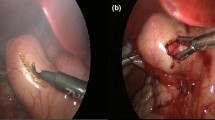Abstract
Background
Laparoscopic pyloromyotomy (LP) is currently accepted as a suitable treatment modality for infantile hypertrophic pyloric stenosis (IHPS). In this report, we describe some technical modifications of LP using a 3- or 5-mm hook with electrocautery as a substitute for a knife for incising the pylorus. The outcomes of LP using a standard retractable pyloromyotomy knife are compared with those of LP using a hook electrocautery.
Methods
The patients with ultrasound proven IHPS who had undergone LP in a single institution from December 2008 to April 2010 were retrospectively analyzed. Incision on the pylorus was made with a 3-mm pyloromyotomy knife in the initial 12 cases. However, in the latter part of the study, a 3- or 5-mm hook with electrocautery was used for the incision. A Maryland dissector was used for completing the pyloromyotomy. The results were compared in terms of duration of surgery, complications, time taken to establish the first full feed, requirement of analgesics, postoperative emesis, and postoperative stay in the hospital. Independent sample t test and the Chi-square test were used for statistical analysis.
Results
Of the 27 patients analyzed, 12 underwent LP using a pyloromyotomy knife and the remaining 15 patients were operated on using a hook with electrocautery instead of the knife. The operating time, time taken to establish the first full feed, and duration of hospital stay were comparable among the two groups with no statistically significant difference. No complications were recorded in either group.
Conclusions
Use of hook electrocautery for incising the pylorus provides a bloodless field without affecting the postoperative recovery and outcome. It also obviates any need of specialized instruments like a pyloromyotomy knife or other sharp instruments for pyloric incision.
Similar content being viewed by others
Explore related subjects
Discover the latest articles and news from researchers in related subjects, suggested using machine learning.References
Ladd WE, Gross RE. Congenital hypertrophic pyloric stenosis. In: Ladd WE, eds. Abdominal surgery of infancy and childhood. Philadelphia: W.B. Saunders, 1941: 1–18.
Ramstedt C. For the operation of congenital pyloric stenosis. Med Klinik 1912;8:1702–1705. [in German]
Gans SL, Berci G. Peritoneoscopy in infants and children. J Pediatr Surg 1973;8:399–405.
Alain JL, Grousseau D, Terrier G. Extramucosal pyloromyotomy by laparoscopy. Surg Endosc 1991;5:174–175.
Bufo AJ, Merry C, Shah R, Cyr N, Schropp KP, Lobe TE. Laparoscopic pyloromyotomy: a safer technique. Pediatr Surg Int 1998;13:240–242.
Hall NJ, Pacilli M, Eaton S, Reblock K, Gaines BA, Pastor A, et al. Recovery after open versus laparoscopic pyloromyotomy for pyloric stenosis: a double-blind multicentre randomized controlled trial. Lancet 2009;373:390–398.
Leclair MD, Plattner V, Mirallie E, Lejus C, Nguyen JM, Podevin G, et al. Laparoscopic pyloromyotomy for hypertrophic pyloric stenosis: a prospective, randomized controlled trial. J Pediatr Surg 2007;42:692–698.
St Peter SD, Holcomb GW 3rd, Calkins CM, Murphy JP, Andrews WS, Sharp RJ, et al. Open versus laparoscopic pyloromyotomy for pyloric stenosis: a prospective, randomized trial. Ann Surg 2006;244:363–370.
Fujimoto T, Lane GJ, Segawa O, Esaki S, Miyano T. Laparoscopic extramucosal pyloromyotomy versus open pyloromyotomy for infantile hypertrophic pyloric stenosis: which is better? J Pediatr Surg 1999;34:370–372.
Greason KI, Allshouse MJ, Thompson WR, Rappold JF, Downey EC. A prospective, randomized evaluation of laparoscopic versus open pyloromyotomy in the treatment of infantile hypertrophic pyloric stenosis. Pediatr Endosurg Innovative Tech 1997;1:175–179.
Scorpio RJ, Tan HL, Hutson JM. Pyloromyotomy: comparison between laparoscopic and open surgical techniques. J Laparoendosc Surg 1995;5:81–84.
Sola JE, Neville HL. Laparoscopic vs open pyloromyotomy: a systematic review and meta-analysis. J Pediatr Surg 2009;44:1631–1637.
Shah AA, Shah AV. Laparoscopic pyloromyotomy using an indigenous endoknife. J Indian Assoc Pediatr Surg 2004;9:46–47.
Abu-Kishk I, Stolero S, Klin B, Lotan G. Myringotomy knife for pyloromyotomy. Surg Laparosc Endosc Percutan Tech 2010;20:e47–49.
Muensterer OJ, Adibe OO, Harmon CM, Chong A, Hansen EN, Bartle D, et al. Single-incision laparoscopic pyloromyotomy: initial experience. Surg Endosc 2010;24:1589–1593.
Author information
Authors and Affiliations
Corresponding author
Additional information
This work was presented at the 22nd Congress of the Asian Association of Pediatric Surgeons held on February 22–24, 2010, Kaula Lampur, Malaysia.
Rights and permissions
About this article
Cite this article
Jain, V., Roy Choudhury, S., Chadha, R. et al. Laparoscopic pyloromyotomy: is a knife really necessary?. World J Pediatr 8, 57–60 (2012). https://doi.org/10.1007/s12519-011-0278-4
Received:
Accepted:
Published:
Issue Date:
DOI: https://doi.org/10.1007/s12519-011-0278-4




